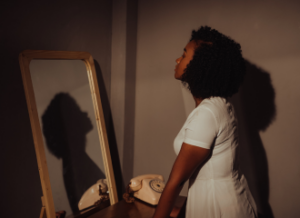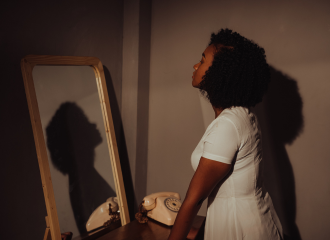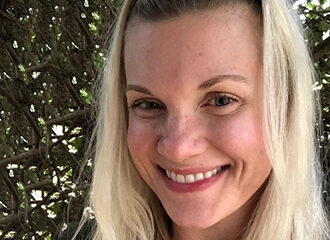Written By: Holly Willis, PMHNP-BC, Nurse Practitioner, The Renfrew Center
Body image issues are a prominent concern in a world that places so much emphasis on physical appearance. While many people may feel insecure or dissatisfied with their bodies from time to time, these feelings can become more serious and severe for others.
What is Body Dysmorphia?
Body dysmorphia is a term that describes certain emotions, behaviors and patterns of thought linked to a preoccupation with flaws in one’s appearance. These flaws are usually perceived to be real, when, in reality, the flaws may be minor or even nonexistent to others. The behaviors associated with body dysmorphia, such as body checking, are frequently associated with disordered eating and eating disorders and can severely impact mental health, relationships, and overall well-being.
In this blog post, we’ll explore what body checking and key signs of body dysmorphia.
What is Body Checking?
Body checking refers to the compulsive habit of repeatedly examining, monitoring, or evaluating one’s appearance or specific body parts. In
Common Forms of Body Checking
Body checking can take many forms. Here are some of the most common ways it shows up:
- Weighing: Stepping on a scale multiple times a day to monitor changes in body weight. Small fluctuations can trigger anxiety or lead to changes in behavior, like eating less or exercising more.
- Examining Photos: Taking photos to evaluate their body or specific body parts. Some individuals may not trust a mirror and want to compare it to photos. Individuals also may take daily photos of their body to look for minor changes or compare to old photos.
- Measuring: Using measuring tapes, clothes, or hands to check the size or shape of particular body parts, often with the belief that minor changes can indicate significant weight gain or loss.
- Mirror Checking: Frequently looking in mirrors or reflective surfaces to scrutinize specific body parts, such as the face, stomach, or thighs. This can happen multiple times throughout the day and last extended periods of time.
- Hiding Perceived Flaws: People with body dysmorphia may frequently avoid social situations where they believe their flaws will be noticed by others. There may be intense fear of judgment and efforts to hide or disguise their flaws in social situations.
- Pinching or Touching: Repeatedly pinching or touching areas of the body, such as the thighs or arms, to assess fat or muscle content.
- Comparing: Constantly comparing oneself to others. Individuals might focus on whether they look “bigger” or “smaller” than someone, often resulting in increased dissatisfaction.
- Clothing Checking: Continuously trying on the same clothing to see how it fits, particularly to check if it feels tighter or looser.
- Seeking Reassurance: People with body dysmorphia may compulsively ask others their opinion about their appearance or seek validation about their body shape or size. This may also include seeking out frequent consultations or evaluations with doctors for validation or solutions to their perceived flaws.
Body checking may offer temporary emotional relief for those struggling with body image concerns, but it paradoxically leads to more anxiety and dissatisfaction in the long run. Rather than eliminating the distress, it negatively reinforces the person’s compulsive behaviors, contributing to a vicious cycle of self-criticism and obsessive thoughts.
Signs of Body Dysmorphia
Recognizing the signs of body dysmorphia is important for identifying when body checking has become problematic. Below are some of the key indicators that someone might be struggling with body dysmorphia:
- Obsessive Thoughts
One of the clearest signs of body dysmorphia is an ongoing, excessive preoccupation with physical appearance, including intrusive, obsessive thoughts about real or perceived flaws. Individuals often spend hours a day thinking about their appearance.
- Frequent Body Checking
Whether it’s using mirrors, weighing themselves repeatedly, or comparing their body to others, individuals may feel compelled to check their appearance multiple times a day.
- Isolation & Social Withdrawal
Due to the intense anxiety about how they look, people with body dysmorphia may avoid social situations where they believe their appearance will be judged. They might avoid having their picture taken by others, choose not to engage in activities like swimming, or isolate themselves altogether from social gatherings.
- Emotional Distress and Impact on Daily Life
Body dysmorphia often causes significant emotional distress and interferes with daily life. Individuals may struggle to focus on work, school, or relationships due to their obsession with their appearance.
- Eating Disorder Symptoms or Disordered Eating
Distress related to body dysmorphia can motivate individuals to take extreme measures to change their body weight, shape, or size. Behaviors aimed at weight loss may include compulsive exercise, fasting, or purging behaviors like laxative abuse or self-induced vomiting.
How to Address Body Checking and Body Dysmorphia
If body checking or body dysmorphia is having a significant impact on your life, it’s important to seek help. These behaviors can become overwhelming, but with the right support and treatment, they can be managed effectively.
- Transdiagnostic Treatment Modalities (UT)
Body Dysmorphic Disorder (BDD) rarely travels alone. Body dysmorphia is frequently experienced alongside other mental health diagnoses, such as anxiety, depression, OCD, and eating disorders. It’s important to choose a treatment approach that targets the underlying factors driving the symptoms of BDD and each co-occurring disorder. Effective therapeutic interventions help individuals improve awareness of their behavioral patterns, challenge rigid thinking, and build tolerance to distressing thoughts, sensations, and urges. Over time, a transdiagnostic approach can help reduce compulsive behaviors, manage obsessive thoughts, and address the symptoms of any co-occurring mental health issues.
- Mindfulness and Self-Compassion Practices
Mindfulness can help individuals become more aware of their body-checking behaviors, their triggers and the emotional avoidance strategies that reinforce compulsive behaviors. Mindfulness creates an opportunity to identify and process the emotions that drive them to engage in these habits. Self-compassion practices can also foster a healthier relationship with one’s body by encouraging acceptance and body neutrality, rather than criticism.
- Limiting Social Media Exposure
Since social media can amplify body comparison and unrealistic beauty standards, reducing time spent on social media platforms may help decrease body checking behaviors. It may also be helpful to curate a more positive online environment or take regular breaks from social media.
- Support from Loved Ones
Talking to trusted friends, family members, or a mental health professional can provide much-needed support for those struggling with body dysmorphia. Loved ones can offer encouragement and help break the cycle of body checking by gently reminding the individual when they are engaging in these behaviors.
- Seek Eating Disorder Treatment
If body dysmorphia is associated with disordered eating behaviors like bingeing, over-exercise, food restriction, or purging, it is important to seek out specialized eating disorder treatment providers to address these concerns.
Conclusion
Body dysmorphia is a significant risk factor for the development of eating disorders and disordered eating. Individuals struggling with body dysmorphia often turn to unhelpful strategies to cope with obsessive thoughts and other distressing emotional experiences. While strategies like body checking may start as attempts to temporarily manage distress, they can ultimately fuel disordered eating, increase anxiety and contribute to greater body dissatisfaction in the long run. Recognizing the signs of body dysmorphia is the first step toward addressing the issue and seeking help. With appropriate treatment and support, individuals can break the cycle of body checking and begin to cultivate a healthier, more positive relationship with their bodies.



